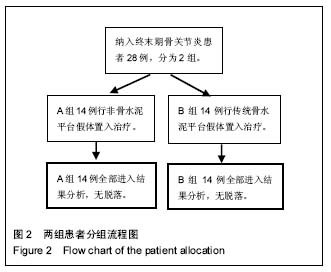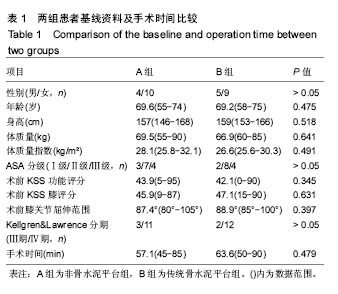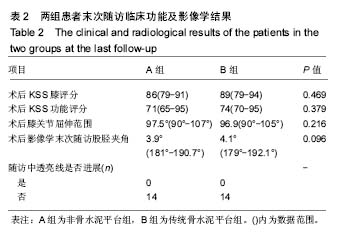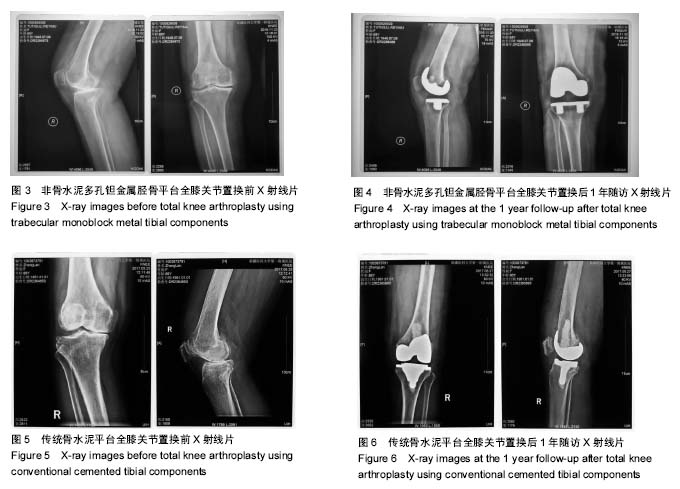中国组织工程研究 ›› 2017, Vol. 21 ›› Issue (35): 5589-5594.doi: 10.3969/j.issn.2095-4344.2017.35.003
• 人工假体 artificial prosthesis • 上一篇 下一篇
非骨水泥多孔钽金属胫骨平台与传统骨水泥平台全膝关节置换的短期疗效对比
李国庆,莫合塔尔•莫敏,马 骏
- 新疆医科大学第一附属医院关节外科,新疆维吾尔自治区乌鲁木齐市 830000
Short-term treatment outcome of the trabecular monoblock metal tibial components versus conventional cemented tibial components in total knee arthroplasty
Li Guo-qing, Mohetaer•Momin, Ma Jun
- Department of Joint Surgery, the First Affiliated Hospital of Xinjiang Medical University, Urumqi 830000, Xinjiang Uygur Autonomous Region, China
摘要:
文章快速阅读:
.jpg) 文题释义:
文题释义:非骨水泥多孔钽金属胫骨平台假体:该假体具有与人类骨最相近的弹性模量从而降低应力遮挡,而多孔化提高了初始的摩擦匹配进而加强假体的初始稳定性及骨长入。然而,非骨水泥多孔钽金属胫骨平台在人工全膝关节置换的应用仍存在争论。有学者怀疑膝关节置换的非骨水泥固定方式影响假体寿命,甚至软组织易与多孔金属粘连而导致术后膝关节僵硬或疼痛。
非骨水泥假体与胫骨平台的匹配度:是预防早期失败的最重要因素。匹配度包含两方面内容:第一,骨水泥假体在安装时,面团期的骨水泥在骨与假体之间可塑型匹配,而非骨水泥平台是与骨的直接压配,因此手术技术的精确性要求更高,胫骨截骨面必须平整光滑,对于假体和截骨面缝隙,原则是零容忍;第二,非骨水泥假体对胫骨平台的完整覆盖。如果覆盖不足致使假体无法座在平台外周的皮质骨上,单纯由内圈的松质骨早期支撑再加上负重应力可能导致早期失败。
摘要
背景:多孔钽金属在人工髋膝关节翻修中提供有效的初始稳定性及优越的骨整合已获得公认,然而非骨水泥多孔钽金属胫骨平台在初次人工全膝关节置换的应用仍存在争论。有学者怀疑膝关节置换的非骨水泥固定方式影响假体寿命,甚至软组织易与多孔金属粘连而导致术后膝关节僵硬或疼痛。
目的:对比采用非骨水泥多孔钽金属胫骨平台与传统骨水泥平台进行全膝关节置换的短期疗效。
方法:选择使用非骨水泥多孔钽金属胫骨平台接受初次单侧人工膝关节置换的患者14例,并随访同期使用传统骨水泥平台进行初次全膝关节置换的患者14例。全部28例患者术前均为终末期骨关节炎。对患者进行临床及影像学随访,随访时间1-3年。
结果与结论:①随访期间2组未出现再次手术病例;②2组患者术后美国膝关节协会膝评分、美国膝关节协会功能评分、膝关节屈伸范围及末次随访股胫夹角对比,差异均无显著性意义(P > 0.05);③2组影像学随访均未发现胫骨侧假体的无菌性松动,胫骨平台下沉及移位;④结果表明,人工全膝关节置换中多孔钽金属胫骨平台的使用能够获得与传统骨水泥平台相近的临床及影像学早期结果,而远期假体生存率需进一步随访。
中国组织工程研究杂志出版内容重点:人工关节;骨植入物;脊柱;骨折;内固定;数字化骨科;组织工程
ORCID: 0000-0001-5645-6726(李国庆)
中图分类号:




.jpg)
.jpg) 文题释义:
文题释义: